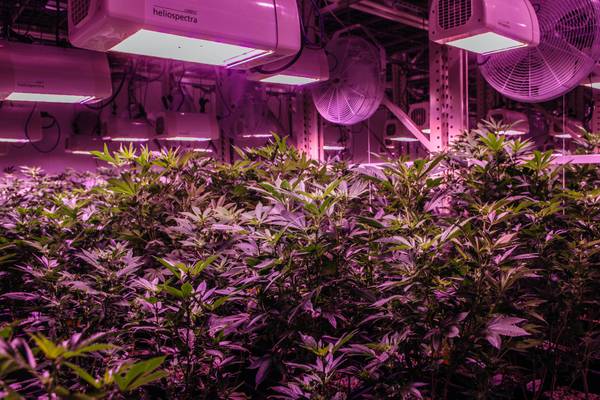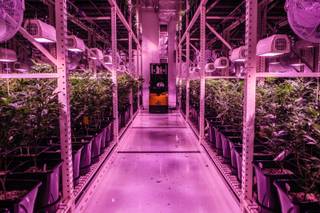Related content
Beneath a purple glow, in a warehouse sharing the street with two indistinguishable strip malls, Kevin Biernacki is growing around 100 pounds of medical marijuana. The purpose of this facility, owned by The Grove, is no different than that of 39 other cultivation sites approved in Clark County. Yet, the roughly 480 industrial lamps suspended over clusters of cannabis set this place apart.
Those energy-efficient lights allowed The Grove to slash its power bill. The decision to use LED lamps might seem unsexy at first, simply a marginal deduction on a complicated balance sheet. But it’s not. It is the type of business decision many experts believe can offer huge benefits in a growing market.
“In the long run, I think it will be an advantage,” Biernacki said.
That’s because indoor cultivation centers, which use lamps to mimic the sun and air conditioning to keep temperatures hospitable, suck up power. NV Energy has projected that some cannabis-growing operations could use up to five megawatts at one time, enough energy to power about 3,000 homes.
Cultivation facilities vary greatly in energy use, according to John Morris, a consultant who specializes in energy efficiency for cannabis operations throughout the West. He estimates energy alone accounts for 38 percent of operational costs. Even when measures are taken to curb use, utility bills can be high. As an example, Morris said an Oregon-based client who’d begun building a large facility with solar panels expected his monthly bill to be about $1 million.
For a long time, he said, the focus of cultivation has been on ramping up production quickly. But as the industry grows, he thinks energy efficiency will come more and more into vogue.
“The top priority is yield and product quality,” said Morris, who runs Resource Innovation Institute, a nonprofit dedicated to tackling issues of energy efficiency and power at cannabis-harvest facilities. “When you can add a layer of energy efficiency on top of that, it lowers your operational cost.”
In Nevada, some of the 55 approved cannabis-cultivation facilities are moving toward efficiency, with the prospect of legal recreational marijuana looming.
“There is a push for greater efficiency in the marijuana world,” said Will Adler, executive director of the Nevada Medical Marijuana Association, adding that power bills as high as $70,000 served as a “wake-up call.”
Power costs for cultivation facilities in Nevada are especially steep because restrictions limit the amount of sunlight growers can use. As medical marijuana laws were being implemented, Nevada officials, citing security risks, enforced a rule requiring cultivation in enclosed, locked facilities that could not be observed from the outside.
That forced operations into warehouses that relied largely on lamps. Traditional high-pressure sodium bulbs created a considerable amount of heat, which demanded more air conditioning, raising electricity bills even further. LED bulbs, with about half the wattage, are cooler and cut costs significantly.
Also, the state has eased its interpretation of the statute, allowing facilities to use tinted roofs that provide access to natural light. Even more than LEDs, this can reduce power costs.
“If you didn’t know this, plants grow outside naturally,” Adler joked.
Carson City recently approved a cultivation and production facility for BioNeva Innovations that incorporates a 75 percent opaque roof, according to planning commission records. The company’s application with Carson City, BioNeva touts other efficiency measures. It will, for instance, such as including a separate mushroom production facility using mushrooms to produce the carbon dioxide required to help marijuana grow.
A big motivator for the company: cutting its energy costs.
Some energy-efficiency programs could be open accessible to these companies through NV Energy, said Mary Simmons, vice president of business development and community strategy with the utility.
In other parts of the country, utilities have seen energy demand increase because of cannabis harvests, with momentum growing for the legalization of marijuana for medical and recreational use. The Denver Post reported that nearly half the city’s electricity growth in 2014 could be attributed to marijuana growers.
With the legalization of recreational pot on Nevada’s November ballot, Simmons said it’s still too early to tell how adding more cultivation sites could affect NV Energy’s demand.
“It really all depends on what’s in the details of the legislation,” she said.
Swedish-based Heliospectra, which produced The Grove’s lamps, said the cultivation center received a rebate from NV Energy. Caroline Nordahl Wells, a Heliospectra vice president of sales and marketing, said that as news spreads, the company expected more demand for the lamps that reduce energy costs and can help accelerate product growth.
Wells applauded The Grove for using sustainable tech: “They’re dispelling the myth that a high-yield cannabis farm requires a huge carbon footprint.”



Join the Discussion:
Check this out for a full explanation of our conversion to the LiveFyre commenting system and instructions on how to sign up for an account.
Full comments policy